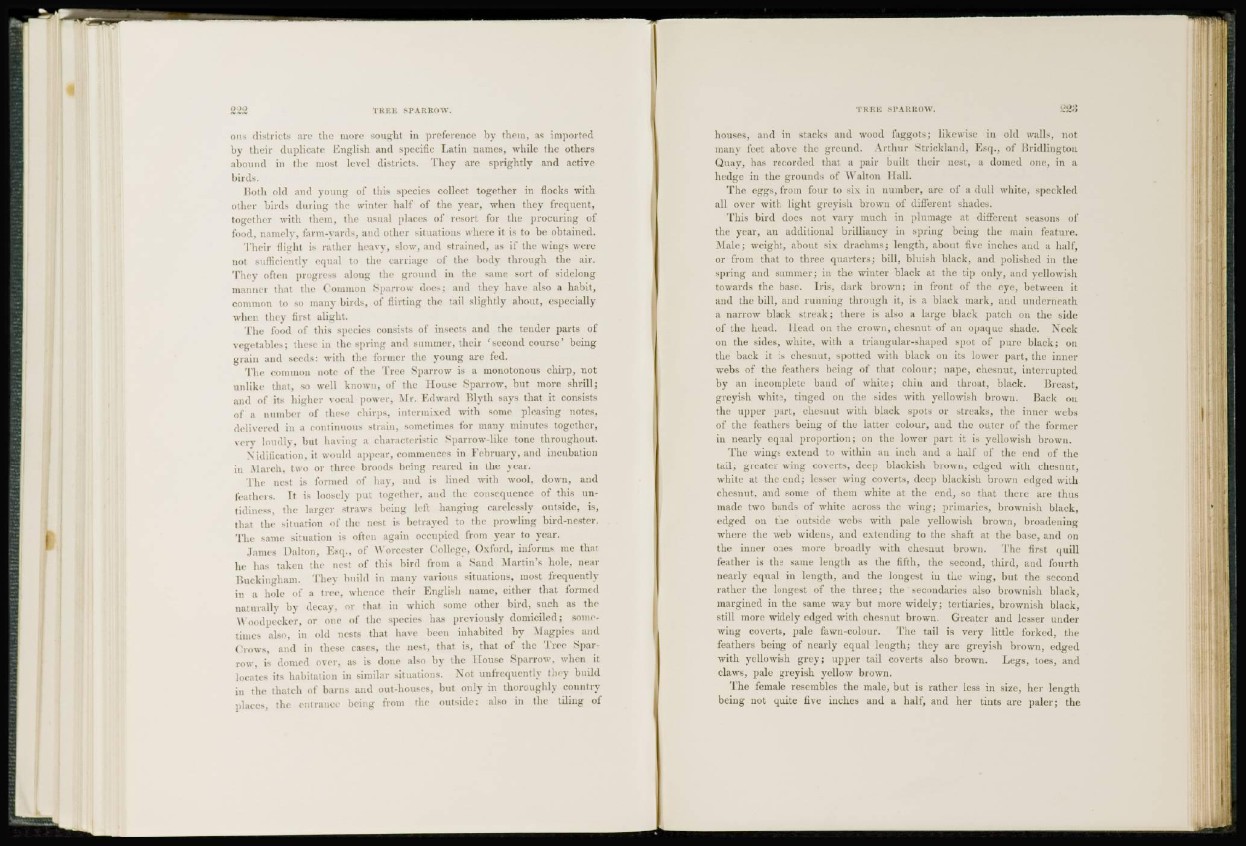
on- districts arc the more sought in preference by them, as imported
by their duplicate English and specific Latin names, while the others
abouml in the most level districts. They are sprightly and active
birds.
Both old and young of this species collect together in flocks with
other birds during the winter half of the year, when they frequent,
together with them, the usual pi .ices of resort for the procuring of
food, namely, farm-yards, and other situations where it is to be obtained.
Their flight is rather heavy, slow, and strained, as if the wings were
not sufficiently equal to the carriage of the body through the air.
They often progress along the ground in the same sort of sidelong
manner that the Common Sparrow doe-; and they have also a habit,
common to so many birds, of flirting the tail slightly about, especially
when they first alight.
The food of this species consists of insects and the tender parts of
vegetables; these in the spring and summer, their 'second course' being
grain and s e e d s : with the former the young an1 fed.
The common note of the Tree Sparrow is a monotonous chirp, not
unlike that, so well known, of the House Sparrow, but more shrill;
anil of it- higher vocal power, Mr. Edward Blyth says that it consists
of a number of these chirps, intermixed with some pleasing notes,
delivered in a continuous strain, sometimes for many minutes together,
very loudly, but having a characteristic Sparrow-like tone throughout.
Nidilication. it would appear, commences in February, and incubation
in .March, two or three broods being reared in the year.
The nest is formed of hay, and is lined with wool, down, and
feathers. It is loosely put together, and the consequence of this untidiness,
the larger straws being left hanging carelessly outside, is,
that the situation of the nest is betrayed to the prowling bird-nester.
The same situation is often again occupied from year to year.
James Dulton, Esq.. of Worcester College, Oxford, informs me that
he has taken the nest of this bird from a Sand Martin's hole, near
Buckingham. They build in many various situations, most frequently
in a hole of a tree, whence their English name, either that formed
naturally by decay, or that in which some other bird, such as the
\\ oodpecker, or one of the specie- has previously domiciled; sometimes
also, in old nests that have been inhabited by Magpies and
Crows, and in these cases, the nest, that is, that of the Tree Sparrow,
i- domed over, as is dime also by the House Sparrow, when it
locates its habitation in similar situations. Not unfrequcntly they build
in the thatch of barns and out-houses, but only in thoroughly country
placcs, the entrance being from the outside; also in the tdiug of
houses, and in stacks and wood faggots; likewise in old wall-, not
many feet above the greund. Arthur Strickland, Esq., of Bridlington
Quay, has recorded that a pair built their nest, a domed one, in a
hedge in the grounds of Walton Hall.
The eggs, from four to six in number, arc of a dull white, speckled
all over with light greyish brown of different shades.
This bird does not vary much in plumage at different seasons of
the year, an additional brilliancy in spring being the main feature.
Male; weight, about six drachms; length, about five inches and a half,
or from that to three quarters; bill, bluish black, and polished in the
spring and summer; in the winter black at the tip only, and yellowish
towards the base. Iris, dark brown; in front of the eye, between it
and the bill, and running through it, is a black mark, and underneath
a narrow black streak; there is also a large black patch on the side
of the head. Head on the crown, chesnut of an opaque shade. Neck
on the sides, white, with a triangular-shaped spot of pure black; on
the back it is chesnut, spotted with black on its lower part, the inner
webs of the feathers being of that colour; nape, chesnut, interrupted
by an incomplete baud of white; chin and throat, black. Breast,
greyish white, tinged on the sides with yellowish brown. Back on
the upper part, chesnut with black spots or streaks, the inner webs
of the feathers being of the latter colour, and the outer of the former
in nearly equal proportion; on the lower part it. is yellowish brown.
The wings extend to within an inch and a half of the end of the
tad; greater wing coverts, deep blackish brown, edged with chesnut,
white at the end; lesser wing coverts, deep blackish brown edged with
chesnut, and some of them white at the end, so that there are thus
made two bands of white across the wing; primaries, brownish black,
edged on the outside webs with pale yellowish brown, broadening
where the web widens, and extending to the shaft at the base, and on
the inner ones more broadly with chesnut brown. The first quill
feather is the same length as the fifth, the second, third, and fourth
nearly equal in length, and the longest in the wing, but the second
rather the longest of the three; the secondaries also brownish black,
margined in the same way but more widely; tertiaries, brownish black,
still more widely edged with chesnut brown. Greater and lesser under
wing coverts, pale fawn-colour. The tail is very little forked, the
feathers being of nearly equal length; they are greyish brown, edged
with yellowish grey; upper tail coverts also brown. Legs, toes, and
claws, pale greyish yellow brown.
The female resembles the male, but is rather less in size, her length
being not quite five inches and a half, and her tints are paler; the